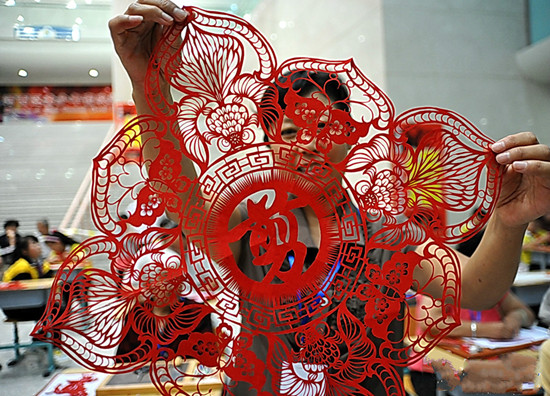Modern paper-cutting must keep heritage, values in focus
Author : Chen Jing Source : Chinese Social Sciences Today 2016-11-07

A contestant of a paper-cutting competition in Tianjin shows her artwork. Chinese paper-cutting was recognized in the UNESCO Intangible Cultural Heritage Lists in 2009. It has a history of more than 1,500 years, representing cultural values of people throughout China.
Paper-cutting is an intricate form of art that is often displayed on windows and doorways. With a staggering 3,000 years of history in China, this form of art has been handed down from generation to generation, and has even spread to the United States, Mexico, Russia, Korea and other countries through cultural exchanges. Different countries and regions adopt different styles with their own cultural elements.
Although people’s lifestyles have changed in modern times, paper-cutting has always maintained a significant presence.
In addition to China, the United States, Germany and Japan also have paper-cutting clubs, art exchanges, and organize exhibitions. After paper-cutting was approved by UNESCO as a form of world intangible cultural heritage, China became the world center of paper-cutting art exchanges. However, finding ways to ensure the art form’s cultural legacy has been an ongoing challenge.
To preserve the legacy of this art, local paper-cutting clubs and organizations across China hold various exhibitions, publish paper-cutting books and organize training classes. While local people often become fans, there have also been some undesirable occurrences that have affected the development of this industry.
In recent years, some officials, artists and business people who barely understand the intangible heritage elements of the art form have gotten involved in the industry and capitalized on hype. This in turn made some cultural organizations fickle and anxious to achieve quick success and instant benefits.
This made them opportunistic. They either plagiarized others’ paper-cuttings or made use of computers and laser machines to achieve mass production. These people aimed for quick achievements and to make money, and disguised their goals under the guise of innovation, leading Chinese paper-cutting toward the track of commercialization, vulgarization and mechanization. Even some judges of paper-cutting contests are very unprofessional, and some art teachers teach students paper-cutting, although they know nothing about it.
Due to the lack of professional teaching and the influences of Western culture, some young Chinese paper-cutting artists blindly worship foreign things and regard getting awards for foreign exhibitions as their highest life pursuit, and feel proud of making huge paper-cutting artworks to achieve Guinness World Records. Some even indicate that traditional folk paper-cutting has no soil to survive upon in China, and instead claim that paper-cutting artworks should be “innovated.” However, these “innovated” artworks are nothing new. In fact, they are only products of computers and laser engraving machines, labeled with the new name “new realism art.” All of these phenomena result in more and more fake and inferior paper-cutting artworks without cultural roots flooding the exhibitions, the classes and the market.
Losing their cultural roots means that paper-cutting will lose the connotations it carries.
The origins and development of traditional paper-cutting are rooted in people’s creativity and understanding of life. A pair of scissors and a piece of red paper are all that is needed to make any shapes the artists wish. The traditional method of paper-cutting is never constrained by the era or style, often adopting exaggeration, overlapping styles and combinations of techniques to express the creators’ thoughts and feelings towards life.
The reason why paper-cutting has lasted for thousands of years is that it is based on Chinese people’s demand for artworks with pleasant aesthetics, and the emotional connotations they have. Both the window paper-cuts and figure paper-cuts glued on the doors are significant symbols of Chinese people’s pursuit of a beautiful life. It is this cultural root that has protected paper-cutting’s vigorous vitality over time. Otherwise, it will lose its artistic soul. Therefore, the innovation of Chinese paper-cutting should be based on the traditional skills and then conform to the times and life.
Ye Shengtao made Chinese fairy tales from a wilderness
Ye Shengtao (1894–1988) created the first collection of fairy tales in the history of Chinese children’s literature...
-
How northern ethnicities integrated into Chinese nation
2023-09-18
-
Mogao caves
2023-09-12
-
Mogao Grottoes as ‘a place of pilgrimage’
2023-09-12
-
Time-honored architectural traditions in China
2023-08-29
-
Disentangling the civilizational evolution of China
2023-08-28
-
AI ethics in science fiction
2023-08-23














 2011-2013 by www.cssn.cn. All Rights Reserved
2011-2013 by www.cssn.cn. All Rights Reserved